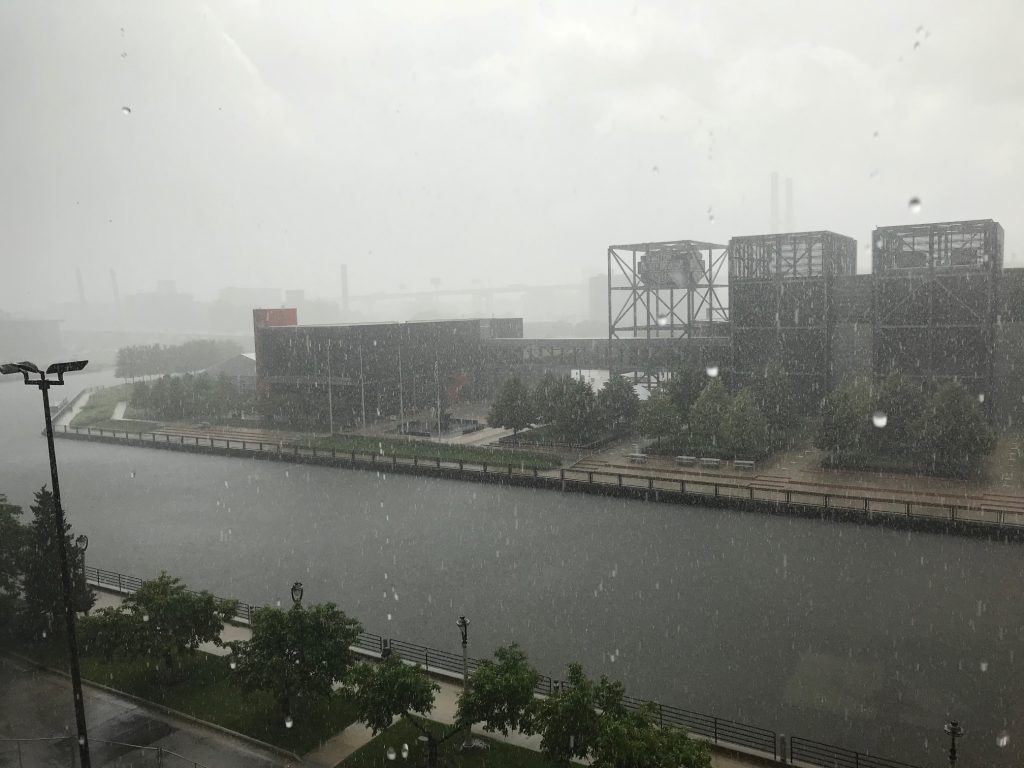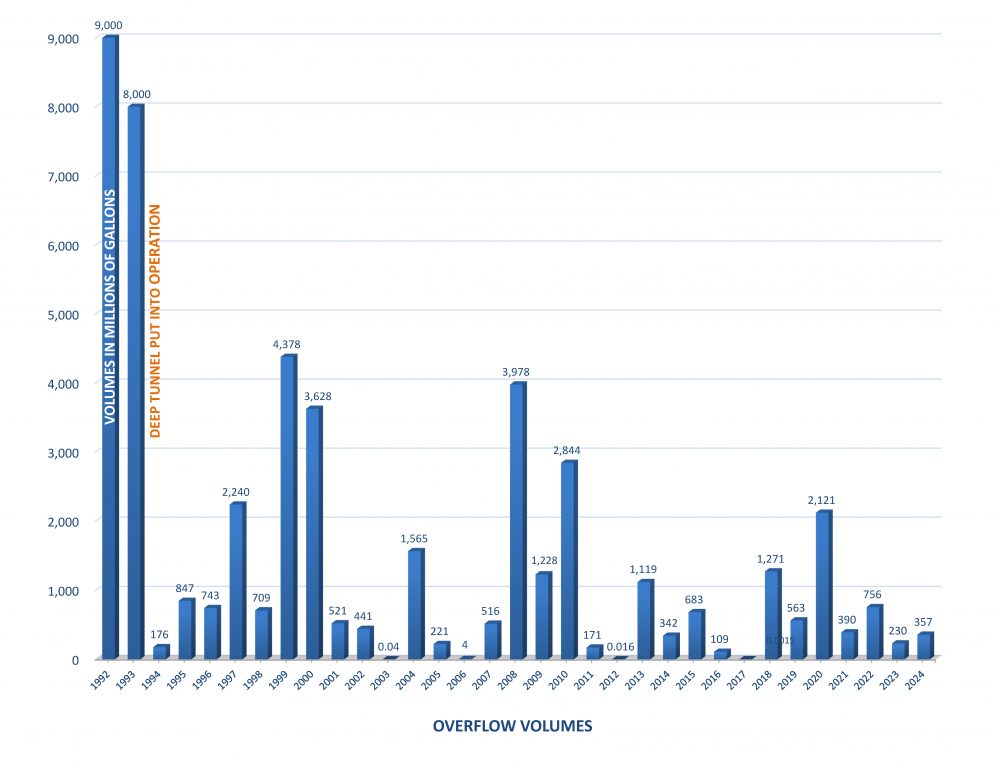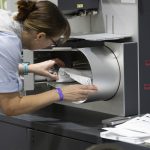Climate Has Changed for Sewerage District
Once trashed by local media and some officials, MMSD now enjoys wide support.

Looking out the windows at MMSD headquarters during a downpour that resulted in the first combined sewer overflow of 2018. Photo courtesy of MMSD.
During the 23 years Charlie Sykes did a conservative talk show for WTMJ, he regularly beat up on the Milwaukee Metropolitan Sewerage District. (MMSD). On a weekly basis he announced a “Deep Tunnel Award” to shame a government official or group for allegedly wasting tax money, thereby reinforcing his mantra that the Deep Tunnel was the greatest governmental boondoggle in regional history.
Whereas, in fact, the massive 521-million gallon Deep Tunnel, which is used to store storm and sewage overflows during big rainfalls, has been a huge success. Before it came on line in 1993, Milwaukee averaged 50 to 60 overflows of polluted water a year into its rivers and Lake Michigan. Since then the average has been just 2.2 per year. Since 1994, MMSD has captured and cleaned an average of 98.6% of every drop of water that’s entered the regional sewer system.
Sykes and WISN radio talker Mark Belling, also a MMSD critic, were helped greatly in their campaign by Milwaukee Journal Sentinel, which for many years ran screaming front-page headlines about sewage being dumped into the lake, without ever making it clear how rare this was — or how much the situation had changed in Milwaukee. Nationally, officials involved in water treatment cite Milwaukee as having one of the most successful operations in the nation, as Urban Milwaukee has reported.
But by the time Sykes quit WTMJ in 2016, the JS coverage had long since transformed (without ever explaining to readers how misleading the past coverage had been). One factor in the newspaper’s change was a study by Professors Erika T. Jensen and Sandra L. McLellan of the highly touted UW-Milwaukee Great Lakes WATER Institute, which found that over a five-year period, the Journal Sentinel did 19 stories blaming sewer overflows for bacterial contamination of beaches. Not one was true, they concluded. Another factor was complaints about the coverage by local public officials representing some of the 28 municipalities served by the MMSD.
Officials with the MMSD have worked steadily to educate the public about the true impact of the Deep Tunnel. “We’ve had good outreach with community groups,” says Kevin Shafer, executive director of the MMSD. “In the 20-some years I’ve been working on this I find people understand better what it is the MMSD does and what they can do to help.”
Still, he admits, there are still social media comments charging the Deep Tunnel is a “boondoggle” that doesn’t work on those rare occasions an overflow occurs as it did last week, when the MMSD had to release 357 million gallons of wastewater into the rivers and lake. So here are the facts about that overflow and how the MMSD works:
-It was the first overflow in 13 months.
-It was caused by four days of rain with a total of 2 inches precipitation. That may not sound like much, but that amounts to 14.2 billion gallons of water deluging the 423-square-mile area of the MMSD, overwhelming the storm and sewer systems of its 28 municipalities and gradually filling the entire backup capacity of the Deep Tunnel, forcing Shafer to approve the overflow.
-Under federal law the MMSD is allowed six overflows per year and has never exceeded that number, and averages just over two per year.
-Many communities in the U.S. struggle to capture and clean the national goal of 85% of all the rain and wastewater that enters their sewer systems, compared to the 98.6% average for the MMSD.
-The $1 billion Deep Tunnel project never promised to end all overflows but to end the vast majority, which it has done. Ending all overflows by massively expanding the deep tunnel would cost $7 billion, a study by Southeastern Wisconsin Regional Planning Commission some 15 years ago found (or $10.5 billion today) and would not address the major remaining problem of stormwater runoff contaminated with oil and gas from streets, fecal waste from pets and wildlife and fertilizer and other lawn chemicals.
A far more cost effective strategy is to “manage runoff water where it falls on the ground,” Shafer notes, so that less total water is surging into the rivers and flowing toward the MMSD sewage facility and overwhelming it. The MMSD has pursued many different strategies to accomplish this:
-A Green Seams project that has purchased 5,400 acres of land in upstream rural areas of the Milwaukee and Menomonee River: spongy, hydric soil that absorbs 3 billion gallons of water and thus doesn’t flow into the rivers during rainfalls.
-Installing green infrastructure: bio-swales, rain barrels, rain gardens, green roofs and porous pavement, all of which reduce stormwater runoff into the sewers and rivers. Currently 140 million gallons are captured this way, but the long-term goal is enough infrastructure to capture 740 million gallons.
-Flood management projects to remove the concrete channels of area streams. The MMSD completed this project for Lincoln Creek and is doing the Kinnickinnic River now and gearing up for Honey Creek. Naturalizing the streams means more water is absorbed and also reduces the speed of swollen streams during major rainfalls.
-A long-term plan to plant 6 million trees and restore 4,000 acres of wetlands that was begun several years ago.
All of this is being done in conjunction with the City of Milwaukee and 27 suburban governments who are served by the MMSD. “We’ve got a really good working relationship with all the municipalities, who are working to reduce the amount of water that leaks into their sewers,” notes Shafer.
All of these improvements are coming even as climate change increases the number of “100-year floods” and major rain events in the area. “We are seeing climate stressors that are impacting our system,” Shafer notes. “We’re going to have a longer rainy season, with more rain falling, mixed with draught.”
Meanwhile the climate has changed greatly when it comes to how the public views the MMSD.
If you think stories like this are important, become a member of Urban Milwaukee and help support real, independent journalism. Plus you get some cool added benefits.
Murphy's Law
-
Top Health Care Exec Paid $25.7 Million
 Dec 16th, 2025 by Bruce Murphy
Dec 16th, 2025 by Bruce Murphy
-
Milwaukee Mayor’s Power in Decline?
 Dec 10th, 2025 by Bruce Murphy
Dec 10th, 2025 by Bruce Murphy
-
Total Cost of Foxconn Is Rising
 Dec 8th, 2025 by Bruce Murphy
Dec 8th, 2025 by Bruce Murphy
























I would be interested in where the statistics came from about the capture and clean rate of other cities in the U.S. vs. MMSD. I have seen similar things on MMSD’s website, but when I asked via a contact form for the source of those statistics (a government report?) they did not answer.
Patricia, I assume the statistics come from the EPA’s Combined Sewer Overflows (CSO) program. Google immediately revealed that program to me. https://www.epa.gov/npdes/combined-sewer-overflows-csos
Thank you, Mr. Johnson, I will check that out!
The Journal Sentinel drumbeat coverage of deep tunnel emergency overflows was not only lacking accuracy and perspective, but it was lazy journalism – a boilerplate article that could be recycled endlessly by simply changing dates and a few numbers.
As Mr. Murphy points out, MMSD and Executive Director Shafer have accomplishments that are the envy of peer organizations.
MMSD is truly unique. A lot of American cities and most cities around the planet simply transport their poop out to rivers or out to sea.
In Milwaukee, we capture 96% of it or so for treatment before sending it to our lake. Sure, I’d like it to be 100%, but I’m not going to stop using my toilet…..
The legacy of Sewer Socialism continues.
great article